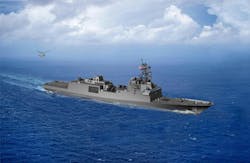Navy orders two more Constellation-class frigates with networked shipboard electronics and weapons
WASHINGTON – The U.S. Navy has ordered the fifth and sixth Constellation-class guided-missile frigates for independent blue-water operations, or to escort carrier battle groups or surface action task forces.
Officials of the Naval Sea Systems Command in Washington announced a $1 billion order on 23 May 2024 to Fincantieri Marinette Marine Corp. in Marinette, Wis., to build the USS Hamilton (FFG 66) and the yet-unnamed FFG 67 Constellation-class frigates.
These ships will be the fifth and sixth in a class of what is to be at least 20 frigates. The hull of the vessel is based on the Italian FREMM-class frigate. The first four ships of the class also are under contract to Fincantieri Marinette Marine.
The Constellation-class frigate will be able to keep up with Navy aircraft carriers and will have sensors networked with the rest of the fleet. It normally will be part of Navy strike groups and large surface combatant-led surface action groups, but also will be able to operate and defend itself while working alone.
Frigates typically are escort vessels that are lighter than destroyers, and help defend aircraft carrier battle groups or merchant convoys from submarines, aircraft, and cruise missiles. They are intended to operate in the open ocean, unlike the Navy littoral combat ship, which is designed to operate in coastal waters and harbors.
The new frigates will have a minimum of 32 Mark 41 Vertical Launch System cells aboard for anti-air warfare. The ships will be designed to destroy surface ships over the horizon; detect enemy submarines; defend convoy ships; employ active and passive electronic warfare systems; and defend against swarming small boat attacks.
Shipboard electronics will include the Lockheed Martin COMBATSS-21 combat management system; AN/SPY-6(V)3 Enterprise Air Surveillance Radar (EASR); AN/SPS-73(V)18 surface search radar; AN/SLQ-61 lightweight towed array sonar; AN/SQS-62 variable-depth sonar; AN/SQQ-89F undersea warfare and anti-submarine warfare (ASW) combat system; and Cooperative Engagement Capability (CEC).
The Constellation-class frigate will be able to fire weaponssuch as the RIM-162 ESSM Block 2 and/or RIM-174 Standard ERAM missiles; RIM-66 Standard SM-2 Block 3C; the Naval Strike Missile; RIM-116 Rolling Airframe Missile; Mk 110 57-millimeter gun; and machine guns. The ship will be able to carry one MH-60R Seahawk helicopter and the MQ-8C Firescout unmanned helicopter.
Related: A once-proud class of U.S. Navy surface warships is quickly fading away
The Constellation and its first two sister ships, the USS Congress (FFG 63) and USS Chesapeake (FFG 64) are named for three of the Navy's six original frigates -- USS Chesapeake; USS Constitution; USS President; USS United States; USS Congress; and USS Constellation -- built between 1797 and 1800. Of these original ships, the USS Constitution still is a Navy commissioned warship and is based in Boston.
The fourth and fifth ships of the class will be named USS Lafayette (FFG 65) and USS Hamilton (FFG 66). Of the first six Constellation-class frigates on order, only the first -- USS Constellation -- is under construction. Its keel was laid down last April, and the ship is expected to join the fleet in 2029. The last of the six ships on order should join the fleet in April 2030. The first 12 Constellation-class frigates will be based in Everett, Wash.
The Constellation-class frigates will replace the Navy's 54 Oliver Hazard Perry-class frigates, which were built between 1977 and 1989. The last Perry-class frigate, USS Ingraham (FFG 61) was decommissioned in 2014 and was sunk as a practice target in 2021.
On this order Marinette Marine will do the work in Marinette, Green Bay, Sturgeon Bay, and Kaukauna, Wis.; Camden, N.J.; Chicago; Pittsburgh; Hauppauge, N.Y.; Cincinnati; Charlotte, N.C.; Bethesda and Millersville, Md.; and Atlanta, and should be finished by April 2030.
About the Author
John Keller
Editor-in-Chief
John Keller is the Editor-in-Chief, Military & Aerospace Electronics Magazine--provides extensive coverage and analysis of enabling electronics and optoelectronic technologies in military, space and commercial aviation applications. John has been a member of the Military & Aerospace Electronics staff since 1989 and chief editor since 1995.

